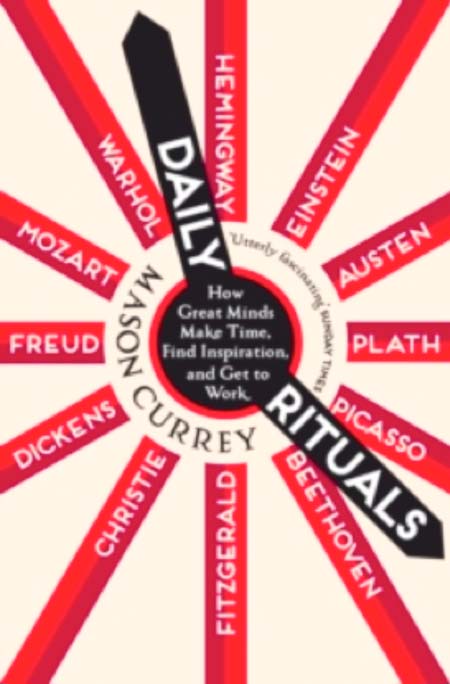
The
Onion published an essay recently called “Find The Thing You’re Most Passionate
About, Then Do It On Nights And Weekends For The Rest Of Your Life.” The piece
was satire, but it’s how many of us respond to the question Mason Currey raises
in his entertaining new book, Daily Rituals: How Artists Work. “How do you do
meaningful creative work,” he wonders, “while also earning a living?”
A
product of the author’s now-defunct blog, Daily Routines, Daily Rituals
assembles the regimens of 161 assorted creative geniuses into a lean, engaging
volume. Its brief entries humanize legends like Hemingway and Picasso, and shed
light on the working lives of less popular contemporary geniuses, like painter
Gerhard Richter, choreographer Twyla Tharp and illustrator Maira Kalman.
The
book makes one thing abundantly clear: There’s no such thing as the way to
create good work, but all greats have their way. And some of those ways are
spectacularly weird.
Nikola
Tesla typically worked from noon until midnight, breaking at 8:00 p.m. for
dinner every night at the Waldorf-Astoria. Among the many peculiarities of this
ritualized repast was his practice of not starting the meal until he had
computed his dinner’s cubic volume, “a compulsion he had developed in his
childhood.” Truman Capote, who wrote lying down in bed or on a couch, refused
to let more than two cigarette butts pile up in an ashtray and “couldn’t begin
or end anything on a Friday.” Louis Armstrong smoked pot (“gage,” as he called
it) almost daily and couldn’t go to sleep until he had taken his dose of a
“potent herbal laxative” called Swiss Kriss. “Armstrong believed so strongly in
its curative powers that he recommended it to all his friends,” Currey writes,
“and even had a card printed up with a photo of himself sitting on a toilet,
above the caption ‘Leave It All Behind Ya.’ “
The
prolific Hungarian mathematician Paul Erdos believed that “a mathematician is a
machine for turning coffee into theorems.” And indeed, if there’s a drug the
artists in Daily Rituals can agree on, it’s caffeine. Soren Kierkegaard
preferred his coffee with sugar, or perhaps it was vice versa: “Delightedly he
seized hold of the bag containing the sugar and poured sugar into the coffee
cup until it was piled above the rim,” his biographer observed. “Next came the
incredibly strong, black coffee, which slowly dissolved the white pyramid.”
In
addition to detailing peculiarities, Daily Rituals, as the name suggests, also
tracks the ordinary routines some of the greatest minds in history employed to
negotiate the daily grind.
James
Joyce, we learn, woke daily around 10:00 a.m. He’d lie in bed for about an
hour, then get up, shave and sit down at his piano, where he’d play and sing
before writing in the afternoon and then hitting the cafes later that evening.
John Updike, meanwhile, worked mornings, preferring to “put the creative
project first,” as he put it. Of his discipline, he said, “I’ve never believed
that one should wait until one is inspired because I think that the pleasures
of not writing are so great that if you ever start indulging them you will
never write again.”
Some
of the creative feats mentioned in the book seem godlike. P.G. Wodehouse, for
instance, wrote the last 8,000 words of ‘Thank You, Jeeves’ in a single day.
Charles
Darwin boasts one of the book’s strictest schedules. After a stroll and
breakfast alone, Darwin would begin a 90-minute work session around 8:00 a.m.
He’d break to read mail with his wife and then return to his study around 10:30
a.m. for a second session. By noon or so, he’d have completed what he
considered his workday, but the rest of his waking hours were no less
regimented. He responded to letters, read and rested at regular intervals until
bedtime, which arrived daily around 10:30 p.m. “Thus his days went for forty
years,” Currey writes, “with few exceptions.”
Some
of the creative feats mentioned in the book seem godlike. P.G. Wodehouse, for
instance, wrote the last 8,000 words of Thank You, Jeeves in a single day. He
was bested by William Faulkner, who once wrote 10,000 words between 10:00 a.m.
and midnight. But these are exceptions to the rule, and there’s something
reassuring about the way most of Daily Rituals’ towering artists and thinkers
struggle with the always difficult, occasionally miserable creative process.
It
even tests someone as preternaturally prolific as Joyce Carol Oates. “Getting
the first draft finished,” she once said, “is like pushing a peanut with your
nose across a very dirty floor.”
Available
at Timbooktoo, tel 4494345


